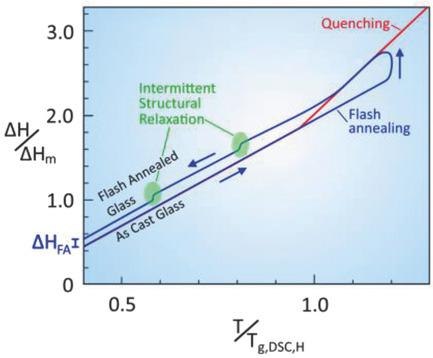当前位置:
X-MOL 学术
›
Adv. Funct. Mater.
›
论文详情
Our official English website, www.x-mol.net, welcomes your
feedback! (Note: you will need to create a separate account there.)
Energy Storage in Metallic Glasses via Flash Annealing
Advanced Functional Materials ( IF 18.5 ) Pub Date : 2018-10-16 , DOI: 10.1002/adfm.201805385 Stefan Küchemann 1 , Peter M. Derlet 2 , Chaoyang Liu 1 , Daniel Rosenthal 1 , Gregory Sparks 1 , William S. Larson 1 , Robert Maaß 1
Advanced Functional Materials ( IF 18.5 ) Pub Date : 2018-10-16 , DOI: 10.1002/adfm.201805385 Stefan Küchemann 1 , Peter M. Derlet 2 , Chaoyang Liu 1 , Daniel Rosenthal 1 , Gregory Sparks 1 , William S. Larson 1 , Robert Maaß 1
Affiliation

|
When the temperature rises in a kinetically frozen and out‐of‐equilibrium system, such as a structural glass, thermal activation usually drives a relaxation to a lower enthalpy state. This is the essence of the ubiquitous thermal ageing of glassy materials below the glass transition temperature. Here, it is shown that an ultrafast temperature rise without subsequent quenching can elevate the system to a higher enthalpy state, thereby erasing the relaxation history. The key of this temperature‐driven rejuvenation is a fast‐heating rate (flash annealing) that brings the glass into a temperature regime above the glass transition within less than a millisecond. Here, the structure is entropically driven towards the liquid state, lowering its free energy, but raising its enthalpy. Subsequent cooling freezes the increased enthalpy before the liquid state is reached, thereby leading to a global energy storage. This ultrafast rejuvenation process is demonstrated for a Zr‐based metallic glass, combining calorimetry, fast in‐situ X‐ray diffraction, and atomistic simulations, showing a tenfold increase in stored enthalpy via flash annealing.
中文翻译:

通过闪光退火在金属玻璃中储能
当在动态冻结且失衡的系统(例如结构玻璃)中温度升高时,热激活通常会将弛豫驱动到较低的焓状态。这是玻璃态材料在玻璃化转变温度以下普遍存在的热老化的本质。在此表明,无需随后的淬火就可以实现超快的温度升高,从而将系统提升至更高的焓态,从而消除了弛豫历史。这种由温度驱动的复兴的关键在于快速加热速率(快速退火),该速率可使玻璃在不到一毫秒的时间内达到高于玻璃化转变温度的温度范围。在此,该结构被熵驱动向液态,从而降低了其自由能,但提高了其焓。随后的冷却在达到液态之前冻结了增加的焓,从而导致了整体能量存储。结合量热法,快速原位X射线衍射和原子模拟,证明了这种基于Zr的金属玻璃的超快复兴过程,该过程通过快速退火使存储的焓增加了十倍。
更新日期:2018-10-16
中文翻译:

通过闪光退火在金属玻璃中储能
当在动态冻结且失衡的系统(例如结构玻璃)中温度升高时,热激活通常会将弛豫驱动到较低的焓状态。这是玻璃态材料在玻璃化转变温度以下普遍存在的热老化的本质。在此表明,无需随后的淬火就可以实现超快的温度升高,从而将系统提升至更高的焓态,从而消除了弛豫历史。这种由温度驱动的复兴的关键在于快速加热速率(快速退火),该速率可使玻璃在不到一毫秒的时间内达到高于玻璃化转变温度的温度范围。在此,该结构被熵驱动向液态,从而降低了其自由能,但提高了其焓。随后的冷却在达到液态之前冻结了增加的焓,从而导致了整体能量存储。结合量热法,快速原位X射线衍射和原子模拟,证明了这种基于Zr的金属玻璃的超快复兴过程,该过程通过快速退火使存储的焓增加了十倍。











































 京公网安备 11010802027423号
京公网安备 11010802027423号